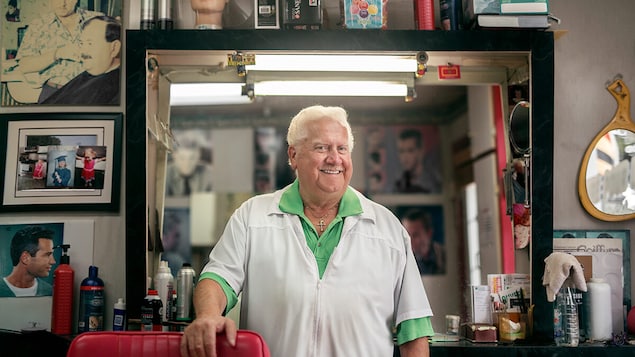There’s Renaud, the bicycle mechanic, Ms. Grandchamp, the lonely tenant, or even Pierre-André, the florist who has just exchanged the flowers of the city for those of the country: Joannie Lafrenière dedicates a small, unique thematic piece to each of these characters.
These different booths house photos, videos, sound recordings or all kinds of accessories, such as the large vase filled with hair to illustrate the work of barber Michel.

Photographer Joannie Lafrenière takes a tender look at the neighborhood that welcomed her almost 20 years ago.
Photo: Roger Aziz
Through this non-linear route, reminiscent of a walk in Hochelaga, we feel the close bond that Joannie Lafrenière has with her neighbor who has lived in the historic working-class district for almost 20 years. The photographer settled there in her early 20s after growing up in the country and embraced the balcony chats that shaped her childhood.
My encounter with Hochelaga was almost as strong as that with photography. A passionate relationship, but a happy ending, I think, she said, laughing, during a press tour of the exhibition on Tuesday.
Intimate Photography
Some of the characters featured in the Hochelaga: Changing Montreal exhibition were first introduced to the public in Joannie Lafrenière’s 2011 short film Hochelaga, mon amour, a testament to the artist’s loyalty to his subjects, who are also friends.

Renaud, a bicycle mechanic who, according to Joannie Lafrenière, works wonders in his workshop
Photo: Joannie Lafreniere
So when we find Claude, who lived for a long time in a container near a railway, we discover the delicate portrait of a man with a penetrating gaze, devoid of voyeurism. A heartbreaking recording left on the artist’s voicemail heralds his disappearance and the end of an era somewhere off Ontario Street.
Then, as we leave the room, our eyes inevitably fall on a poem written on the wall that suddenly seems to acquire its full meaning: Mourning: of the gaze and of the place. None of this will remember us.
These are the words of the poet Benoit Bordeleau, also in love with the Hochelaga district. His verses accompany people throughout their visit, slipping here and there between portraits and videos. These arrangements of atmospheres, sounds and textures are the result of a rich collaboration between the photographer and the scenographer Pierre-Étienne Locas.
One of the rooms in the exhibition presents the rich collection of historical photos of Yvon and Lise who live in the neighborhood.
Photo: Radio Canada / Zacharie Routhier
While each cabin reveals a unique world designed according to the character it is dedicated to, the corridors also have their own themes and colors: one of them, Neon Color, is dedicated to the nocturnal fauna of Hochelaga; another features the testimony of Sylvie, an employee at the local paper mill, speaking about the Ontario boardwalk; further we see images of anonymous characters walking their dog or sleeping on the street.
I wanted to represent Hochelaga with its light and with its shadows. I didn’t want to be unhappy, explains Joannie Lafrenière.
“I hope it touches your heart, but also makes you think. »
— A quote from Joannie Lafrenière
The corridors of the exhibition bring together photos and multimedia content of all kinds. This shows images of Hochelaga at night.
Photo: Radio Canada / Zacharie Routhier
A pinch of nostalgia
What is left of the Hochelaga from 20 years ago? When she talks about it, Joannie Lafrenière already awakens a longing for another time.
As mentioned in the name of the series (Montréal en mutation) to which this exhibition belongs, Hochelaga is changing and, in her opinion, becoming bourgeois, even if its transformation is slower than Griffintown, photographer Robert Walker’s first neighborhood shown in the series at McCord Stewart Museum in 2020.
Her heart aches when she thinks of Sylvie, the waitress who knew her order by heart at La Québécoise restaurant, which has now been replaced by a pawn shop. Or by watching the condominiums sprouting up washing lines and crooked sheds in the background, to which she also dedicates part of her exhibition.
 Enlarge picture (New window)
Enlarge picture (New window)Hochelaga shows itself in all its colors in Joannie Lafrenière’s exhibition.
Photo: Joannie Lafrenière
Joannie Lafrenière says she feels Hochelaga is at a tipping point, at a precarious balance between what the neighborhood is and what it threatens to become as it is redeveloped through gentrification.
This is one of the reasons that prompted Joannie Lafrenière to show her photos and her encounters in the museum. She wants to take care of the people and facilities that she believes are the color of the neighborhood in order to preserve its uniqueness for as long as possible.
As a member of this ecosystem, the photographer has reserved one of the exhibition spaces for her own universe of wallpaper with an orange pattern, reminiscent of her series of self-portraits Bonjour je m ‘calls (New Window).
 Enlarge picture (New window)
Enlarge picture (New window)According to Joannie Lafrenière, the Hochelaga district is slowly but surely changing.
Photo: Joannie Lafrenière
Imagine Hochelaga
Always with the aim of giving back to Hochelaga, residents of the neighborhood can visit the exhibition for free on June 3 afternoon during a day of activities, provided they bring proof of address. .
A round table on “Imagining Hochelaga” is also planned for Wednesday 19 April at 7pm, bringing together Hochelaga-based artists Joannie Lafrenière, Benoit Bordeleau and Caroline Breault.
The curious can visit the neighborhood with the photographer on June 4th and 10th, while a screening of some of his short and medium films is scheduled on September 1st in the Dairy Queen car park at 4545, rue Sainte-Katherine East.
With its 2018 Changing Montreal series, the McCord Stewart Museum aims to document in images the social and infrastructural changes in Montreal’s neighborhoods that are under pressure from real estate development.

